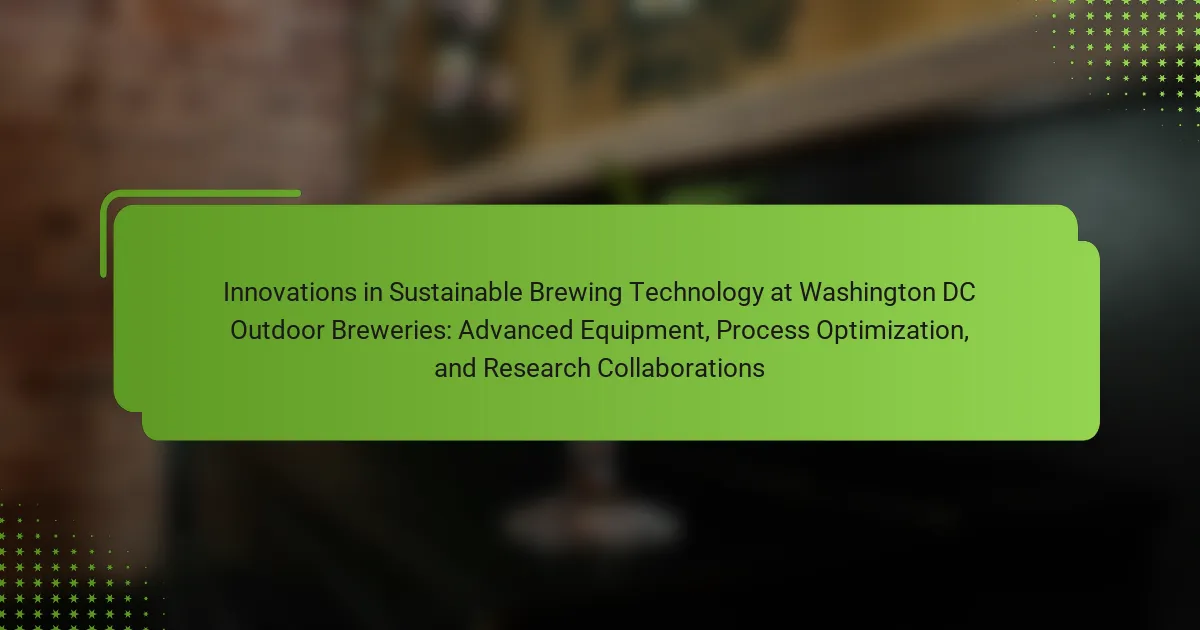The article focuses on innovations in sustainable brewing technology at outdoor breweries in Washington DC. It highlights key advancements such as the use of solar energy, water recycling systems, and advanced fermentation techniques that enhance sustainability while minimizing environmental impact. The article also addresses challenges faced by these breweries, including high initial costs, funding limitations, regulatory hurdles, and the need for specialized training. Furthermore, it discusses future trends, including increased adoption of renewable energy sources, improved water conservation methods, and eco-friendly packaging materials, all reflecting a commitment to environmental sustainability within the brewing industry.

What are the key innovations in sustainable brewing technology at Washington DC outdoor breweries?
Key innovations in sustainable brewing technology at Washington DC outdoor breweries include the use of solar energy, water recycling systems, and advanced fermentation techniques. Solar energy is harnessed to power brewing equipment, reducing reliance on fossil fuels. Water recycling systems are implemented to minimize water waste during the brewing process. Advanced fermentation techniques, such as using natural yeast strains, enhance flavor while reducing chemical additives. Additionally, many breweries engage in local sourcing of ingredients, which decreases transportation emissions. These practices collectively contribute to a more sustainable brewing operation in the region.
How are advanced equipment and technology shaping the brewing process?
Advanced equipment and technology are significantly shaping the brewing process by enhancing efficiency and consistency. Automated brewing systems allow for precise control of temperature and timing. This results in improved flavor profiles and reduced waste. Advanced filtration technologies ensure cleaner beer with fewer impurities. Additionally, data analytics tools optimize ingredient usage and production schedules. Smart sensors monitor fermentation in real-time, allowing for timely adjustments. These innovations lead to higher quality products and increased production capacity. Studies show that breweries adopting such technologies experience up to a 20% increase in output and a 15% reduction in operating costs.
What types of advanced equipment are being utilized in these breweries?
Advanced equipment utilized in these breweries includes automated brewing systems, high-efficiency heat exchangers, and advanced fermentation tanks. Automated brewing systems streamline the brewing process, enhancing consistency and efficiency. High-efficiency heat exchangers improve energy conservation during the brewing process. Advanced fermentation tanks allow for precise temperature and pressure control, optimizing yeast activity. Additionally, some breweries use inline monitoring systems for real-time quality control. This equipment supports sustainable practices by reducing waste and energy consumption. The integration of such technologies is essential for modern brewing operations aiming for sustainability.
How does this equipment improve efficiency and sustainability?
This equipment enhances efficiency and sustainability by optimizing brewing processes. It reduces energy consumption through advanced temperature control systems. These systems maintain precise brewing temperatures, minimizing waste. Additionally, the equipment utilizes water-saving technologies that cut water usage by up to 30%. It also incorporates renewable energy sources, such as solar panels, to power operations. This transition to renewables decreases the carbon footprint of brewing activities. Furthermore, the equipment is designed for easy maintenance, which prolongs its lifespan and reduces resource use. Overall, these innovations lead to more sustainable brewing practices while improving operational efficiency.
What role does process optimization play in sustainable brewing?
Process optimization significantly enhances sustainable brewing by reducing resource consumption. It minimizes water and energy usage during production. Efficient processes lead to lower waste generation. For instance, breweries that optimize their fermentation process can achieve higher yields. This not only conserves ingredients but also reduces overall environmental impact. Studies indicate that optimized brewing methods can cut energy costs by up to 30%. Additionally, process optimization often involves the use of advanced equipment that is designed for efficiency. This technological integration further supports sustainability goals in the brewing industry.
What specific process optimizations are being implemented?
Specific process optimizations being implemented include energy efficiency improvements and waste reduction techniques. Breweries are adopting heat recovery systems to utilize waste heat from brewing processes. This reduces energy consumption by up to 30%. Additionally, water conservation methods are being integrated, such as closed-loop systems that recycle water. These systems can decrease overall water usage by 50%. Breweries are also employing automation technologies for precise control over brewing parameters. This enhances consistency and reduces material waste. Implementing these optimizations not only improves sustainability but also lowers operational costs significantly.
How do these optimizations contribute to resource conservation?
Optimizations in brewing technology significantly contribute to resource conservation by enhancing efficiency and reducing waste. Advanced equipment minimizes energy consumption during brewing processes. Process optimization leads to better ingredient usage, decreasing raw material waste. For instance, energy-efficient boilers can reduce fuel use by up to 30%. Improved water management systems can cut water usage by 50%, conserving this vital resource. These innovations not only lower operational costs but also lessen the environmental impact. By adopting these practices, breweries can significantly decrease their carbon footprint and promote sustainability in the industry.
Why are research collaborations important for sustainable brewing innovations?
Research collaborations are essential for sustainable brewing innovations because they foster knowledge sharing and resource pooling. These partnerships enable breweries to access cutting-edge research and technologies. Collaboration with academic institutions can lead to breakthroughs in sustainable practices. Joint projects often result in more efficient brewing processes and reduced environmental impact. For example, studies have shown that collaborative efforts can enhance energy efficiency by up to 30%. Moreover, sharing best practices helps in developing innovative solutions tailored to local challenges. Ultimately, these collaborations drive the industry towards a more sustainable future.
What types of organizations are involved in these collaborations?
Collaborations in sustainable brewing technology involve various types of organizations. These include breweries, research institutions, and universities. Additionally, non-profit organizations focused on sustainability often participate. Equipment manufacturers also play a crucial role in these collaborations. Government agencies may provide funding and support for innovation. Industry associations help facilitate partnerships among stakeholders. Each organization contributes unique expertise and resources to advance sustainable practices in brewing.
How do these partnerships enhance technological advancements?
Partnerships enhance technological advancements by fostering collaboration between diverse expertise. These collaborations lead to innovative solutions tailored to specific challenges in brewing technology. For example, partnerships with research institutions can provide access to cutting-edge research and development. Collaborating with technology providers can introduce advanced equipment that improves efficiency. Additionally, sharing resources and knowledge accelerates the adoption of sustainable practices. This synergy often results in the development of new brewing processes that minimize environmental impact. Studies show that collaborative innovation can increase productivity by up to 30%. Thus, partnerships are crucial for driving progress in sustainable brewing technology.
How do Washington DC outdoor breweries measure the success of their innovations?
Washington DC outdoor breweries measure the success of their innovations through various metrics. They track customer feedback to gauge satisfaction with new products. Sales figures are analyzed to determine the financial impact of innovations. Additionally, breweries monitor production efficiency improvements resulting from new technologies. They also assess environmental impact reductions, such as decreased water and energy usage. Collaborations with research institutions provide data on brewing process advancements. These measures collectively help breweries understand the effectiveness of their innovations.
What metrics are used to evaluate sustainability improvements?
Common metrics used to evaluate sustainability improvements include carbon footprint, water usage, and energy consumption. Carbon footprint measures greenhouse gas emissions associated with brewing processes. Water usage tracks the amount of water consumed in production. Energy consumption assesses the total energy used during brewing operations. Additional metrics may include waste reduction, resource efficiency, and supply chain sustainability. These metrics provide quantifiable data to assess and compare sustainability efforts effectively.
How do breweries assess the impact of new technologies on their operations?
Breweries assess the impact of new technologies on their operations through systematic evaluation methods. They conduct pilot tests to measure efficiency gains and quality improvements. Data collection occurs during these tests to analyze production metrics. Breweries also gather feedback from staff on usability and workflow changes. Cost-benefit analysis is performed to determine financial implications. Collaboration with technology providers aids in understanding potential benefits. Industry benchmarks are compared to assess competitive advantages. Additionally, customer feedback is integrated to evaluate product quality and satisfaction.

What challenges do Washington DC outdoor breweries face in adopting sustainable brewing technologies?
Washington DC outdoor breweries face several challenges in adopting sustainable brewing technologies. High initial costs for advanced equipment deter many breweries. Limited access to funding and grants further complicates investments in sustainability. Regulatory hurdles can slow the implementation of new technologies. Additionally, the need for specialized training for staff can create further obstacles. Competition for resources and expertise in the local market can also hinder progress. Finally, consumer demand for sustainable practices is still growing, which may affect the urgency to adopt these technologies.
How do regulatory requirements affect innovation in brewing technology?
Regulatory requirements significantly influence innovation in brewing technology. They establish safety and quality standards that must be met. Compliance can drive brewers to adopt advanced technologies for efficiency. For instance, regulations on waste management encourage breweries to innovate in sustainable practices. Additionally, stringent labeling requirements push for transparency in ingredients, fostering new product development. Historical data indicates that breweries investing in compliance technologies often see increased market competitiveness. Overall, while regulations can impose constraints, they also stimulate creative solutions within the brewing industry.
What specific regulations must breweries comply with?
Breweries must comply with federal, state, and local regulations. At the federal level, breweries are regulated by the Alcohol and Tobacco Tax and Trade Bureau (TTB). They must obtain a brewer’s notice before production. State regulations vary but often include licensing requirements and health inspections. Local regulations may cover zoning, waste disposal, and business permits. Compliance with the Food and Drug Administration (FDA) regulations is also necessary for labeling and safety standards. These regulations ensure product safety and proper taxation.
How do these regulations influence the choice of technologies?
Regulations significantly influence the choice of technologies in sustainable brewing. Compliance with environmental standards drives breweries to adopt energy-efficient systems. These regulations often mandate waste reduction and water conservation methods. Consequently, breweries may invest in technologies like closed-loop water systems. Additionally, regulations can incentivize the use of renewable energy sources. For instance, solar panels may be chosen to meet energy efficiency requirements. The need for traceability and quality assurance also shapes technology selection. Many breweries implement advanced monitoring systems to ensure compliance with safety standards. Overall, regulations guide breweries toward innovative and sustainable technological solutions.
What financial considerations impact the adoption of sustainable practices?
Financial considerations significantly impact the adoption of sustainable practices. Initial investment costs for sustainable technologies can be high. Breweries may face financial barriers like equipment upgrades and training expenses. Operational costs may decrease over time due to efficiencies gained from sustainable practices. Long-term savings can be realized through reduced energy and water usage. Access to grants or incentives can alleviate upfront costs. Market demand for sustainable products can lead to increased sales revenue. Additionally, potential penalties for non-compliance with environmental regulations can influence financial decisions.
What are the initial costs associated with advanced brewing equipment?
Initial costs associated with advanced brewing equipment can range significantly. Basic systems start around $10,000. More sophisticated setups can exceed $100,000. These costs include brewing kettles, fermenters, and control systems. Installation and setup may add additional expenses. Maintenance and operation costs should also be considered. Research indicates that investing in quality equipment can enhance production efficiency. Efficient systems may lead to cost savings over time.
How can breweries secure funding for sustainability initiatives?
Breweries can secure funding for sustainability initiatives through grants, loans, and partnerships. Government programs often provide grants aimed at promoting sustainable practices. Non-profit organizations also offer funding opportunities for environmental projects. Breweries can apply for low-interest loans from financial institutions focused on green initiatives. Collaborating with local universities can lead to research grants and joint projects. Crowdfunding platforms allow breweries to engage their community in funding efforts. Additionally, breweries can seek sponsorships from companies that prioritize sustainability. These avenues have been successful in supporting breweries’ sustainability goals.

What future trends can be expected in sustainable brewing technology?
Future trends in sustainable brewing technology include increased use of renewable energy sources. Breweries are adopting solar and wind power to reduce carbon footprints. Water conservation techniques are also becoming more prevalent. Technologies such as closed-loop water systems minimize waste. Additionally, there is a shift towards using local ingredients. This supports local agriculture and reduces transportation emissions. Innovations in fermentation processes are expected to enhance efficiency. These processes can lower energy consumption and improve yield. Furthermore, advancements in packaging materials are anticipated. Eco-friendly packaging will reduce landfill waste. These trends reflect a broader commitment to environmental sustainability in the brewing industry.
How is consumer demand influencing brewing innovations?
Consumer demand is significantly influencing brewing innovations by driving breweries to adopt sustainable practices. As consumers increasingly prioritize eco-friendly products, breweries are innovating to reduce their environmental impact. For instance, many are implementing energy-efficient brewing equipment to minimize energy consumption. Additionally, there is a growing trend towards sourcing local ingredients, which reduces transportation emissions and supports local economies. Research shows that 66% of consumers are willing to pay more for sustainable brands, prompting breweries to enhance their sustainability efforts. Moreover, breweries are exploring alternative packaging solutions, such as biodegradable materials, to meet consumer preferences. This shift in demand is not only reshaping product offerings but also influencing the entire brewing process. Overall, consumer preferences are a key driver of innovation in the brewing industry.
What preferences are emerging among consumers regarding sustainability?
Consumers increasingly prefer sustainable products and practices. This trend reflects a growing awareness of environmental issues. Many consumers seek transparency in sourcing and production methods. They favor brands that demonstrate commitment to eco-friendly practices. A survey by Nielsen found that 73% of millennials are willing to pay more for sustainable brands. Additionally, consumers are gravitating towards local products to reduce carbon footprints. The demand for recyclable and biodegradable packaging is also rising. These preferences are shaping market strategies across various industries, including brewing.
How do these preferences drive technological advancements?
Consumer preferences for sustainability drive technological advancements in brewing. Breweries are responding to increased demand for eco-friendly practices. This includes implementing energy-efficient equipment and waste reduction technologies. For instance, many breweries now utilize solar panels to power operations. Additionally, preferences for local sourcing lead to innovations in supply chain efficiency. Research collaborations often focus on developing biodegradable packaging solutions. These advancements not only meet consumer expectations but also enhance operational efficiency. The shift towards sustainable practices has resulted in a significant reduction in carbon footprints across the industry.
What are some best practices for implementing sustainable brewing technologies?
Best practices for implementing sustainable brewing technologies include optimizing energy use, reducing water consumption, and minimizing waste. Breweries should invest in energy-efficient equipment such as heat exchangers and variable frequency drives. Implementing water recycling systems can significantly lower water usage. Waste management practices, including composting and recycling, help reduce landfill contributions. Additionally, sourcing local ingredients decreases transportation emissions. Training staff on sustainability practices enhances overall efficiency. Monitoring and reporting sustainability metrics can track progress and guide improvements. These practices contribute to a more environmentally friendly brewing process.
What strategies can breweries adopt to ensure successful implementation?
Breweries can adopt several strategies to ensure successful implementation of sustainable brewing technologies. First, they should invest in advanced equipment that optimizes energy and water usage. This can lead to significant cost savings and reduced environmental impact. Second, breweries should engage in process optimization to streamline operations. This includes evaluating fermentation and packaging processes for efficiency. Third, collaboration with research institutions can provide access to innovative practices and technologies. Such partnerships can enhance knowledge and drive improvements. Fourth, training staff on new technologies is essential for effective implementation. Educated employees can better utilize advanced systems and maintain quality. Lastly, continuous monitoring and assessment of sustainability metrics can guide adjustments and improvements over time. These strategies collectively enhance operational efficiency and sustainability in brewing.
How can breweries continuously improve their sustainability efforts?
Breweries can continuously improve their sustainability efforts by implementing energy-efficient technologies. Upgrading to energy-efficient brewing equipment can reduce energy consumption by up to 30%. Utilizing renewable energy sources, such as solar or wind, further decreases carbon footprints. Water conservation practices, including closed-loop systems, can save significant amounts of water, often by 50% or more. Implementing waste reduction strategies, like repurposing spent grains for animal feed, minimizes landfill contributions. Collaborating with local farmers for resource sharing enhances community sustainability. Regularly assessing and optimizing processes ensures ongoing improvements in efficiency and sustainability.
The main entity of this article is sustainable brewing technology at outdoor breweries in Washington DC. The article provides an overview of key innovations such as solar energy utilization, water recycling systems, and advanced fermentation techniques that enhance sustainability. It examines how advanced equipment and process optimization improve efficiency and reduce waste while discussing the importance of research collaborations in fostering technological advancements. Additionally, the article addresses the challenges faced by breweries in adopting these technologies and highlights emerging consumer preferences that drive sustainability efforts.
